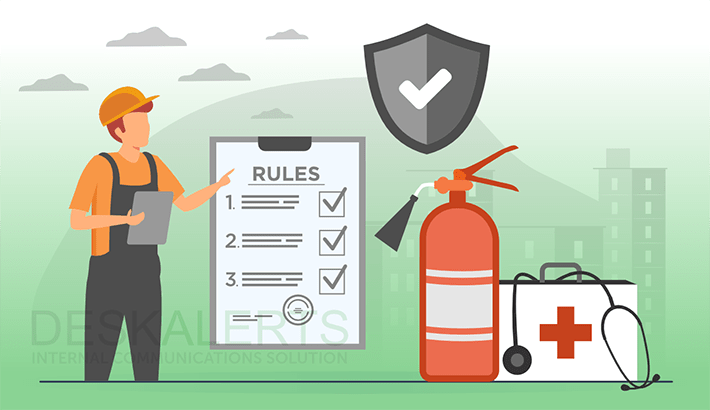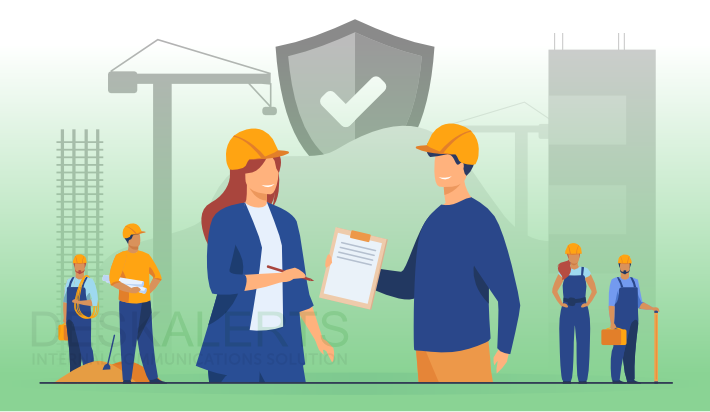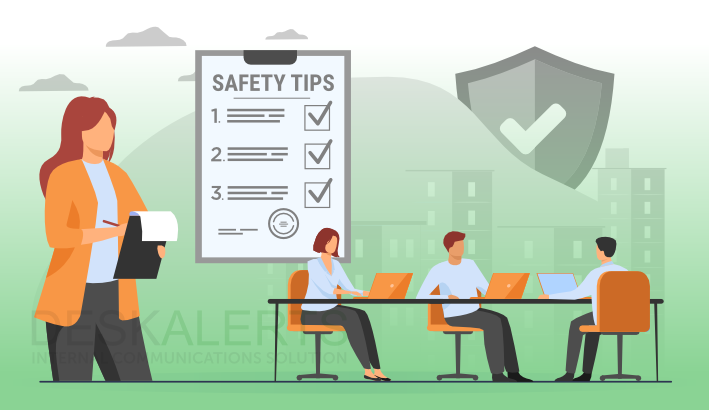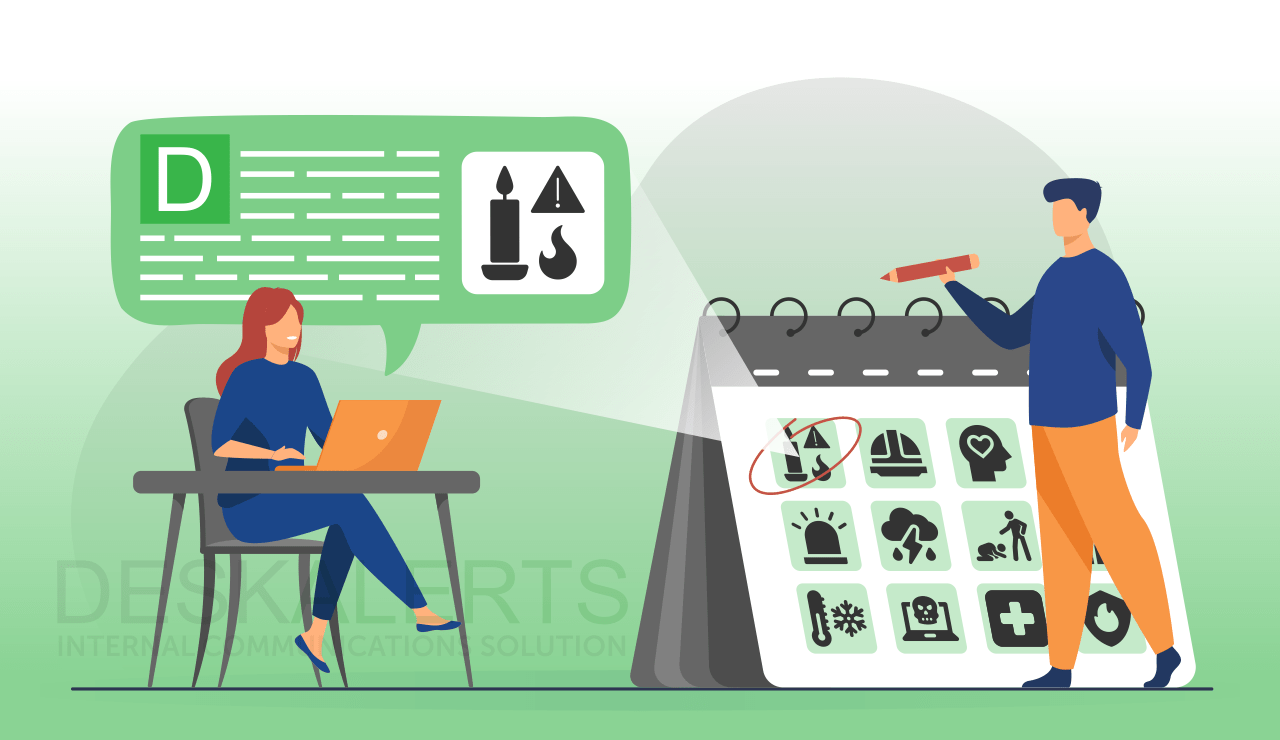
Health and safety in the workplace needs to be front-of-mind for every business, regardless of the industry it operates in. While safety topics provide a comprehensive framework, incorporating a 'safety tip of the day' can help ensure that key practices are regularly reinforced. Safe workplaces help ensure employees' health and wellbeing, and employers have both a legal and moral obligation to provide one.
Unsafe workplaces can lead to serious injury and death and a cascade effect of other issues, including absenteeism, presenteeism, shut downs, legal issues, regulatory fines and even criminal prosecutions depending on the issue and the jurisdiction of the company. Companies can also experience productivity losses and even reputational damage.
The problem is one you can’t afford to ignore: according to a 2023 report from the US Bureau of Labor Statistics, non-fatal workplace injuries and illnesses increased by 7.5% from 2021 to 2022.
Table of contents
Why is communication important for workplace safety?
What are workplace safety messages and why do you need them?
30 safety topics and messages to send in 2024
How to make short safety talks interesting and effective
Why is communication important for workplace safety?
Communication is a key cornerstone to improving workplace safety. It ensures that employees are aware of potential hazards, safety protocols, and emergency procedures. Clear, effective communication also establishes a common understanding among the workforce, reducing the likelihood of accidents due to misinformation or lack of knowledge.
Good communication also enables swift and efficient responses to any potential dangers. Whether it's reporting a hazard, signaling an emergency, or conveying critical information on a range of safety topics, integrating a safety tip of the day ensures that necessary actions can be taken promptly, mitigating risks and preventing accidents.
In a collaborative environment, communication fosters a culture of safety. Employees who feel comfortable discussing safety concerns and safety topics are more likely to identify and address potential hazards, contributing to a proactive safety culture.
What are workplace safety messages and why do you need them?
A key component of best practice workplace health and safety communications is sending workplace safety messages to employees that provide hints, tips and safety ideas. Adding a safety tip of the day can make these messages more actionable and engaging, ensuring daily reinforcement of essential practices.
These are concise, targeted communications that convey critical information about safety protocols, hazards, and best practices within a particular work environment. They serve as reminders, warnings or provide guidance to promote a safe workplace culture, and cover a variety of safety topics for work.
These messages can take various forms, including posters, emails, meetings, training sessions or can even be incorporated into digital signage.
Important points to know about workplace safety topic messages include:
- They reinforce awareness by reminding employees about safety protocols, potential hazards, and the importance of adhering to safety guidelines.
- Repetition and consistency in these messages help ingrain safety practices into daily routines, reducing complacency and oversights.
- They serve as educational tools. They can be used to disseminate new safety procedures, updates, or information about potential risks in the workplace.
- They act as motivational tools, encouraging a culture of safety where everyone feels responsible for their well-being and that of their colleagues.
- Workplace safety messages foster a sense of community and shared responsibility, where individuals are empowered to actively contribute to a safe working environment.
Overall, these messages on workplace safety topics are crucial in sustaining a workplace culture where safety is a priority, reducing accidents and promoting a healthy, secure, and productive work setting.
30 safety topics and messages to send in 2024
Ensuring a safe workplace can start today. We’ve created the following compilation of safety topics you can use as a guide for maintaining a safe work environment and fostering a culture of well-being within your organization. Enhance this strategy by including a daily safety tip of the day to keep safety practices at the forefront.
1. Importance of proper lifting techniques
Ignoring proper lifting leads to back injuries, strains, and workplace accidents, impacting productivity, causing pain, and potentially resulting in long-term health issues.
Suggested communications messaging:
"Protect your back! Use proper lifting techniques: bend at the knees, keep the load close, and lift with your legs. Prioritize safety, avoid strain, and prevent injuries."
2. Prevention of slips, trips and falls
Slips, trips, and falls pose risks of injuries, fractures, sprains and even serious disabilities. They not only affect employee well-being and productivity, they also increase healthcare costs and absenteeism.
Suggested communications messaging:
"Watch your step! Prevent slips, trips, and falls. Keep walkways clear, report spills promptly and use handrails. Your alertness keeps everyone safe. Stay cautious, avoid hazards, and safeguard your well-being."
3. Fire safety and evacuation procedures
Knowledge of fire and evacuation procedures saves lives, minimizes panic, and ensures a swift, organized response during emergencies.
Suggested communications messaging:
"Know the exits! Familiarize yourself with fire alarms, evacuation routes, and assembly points. In an emergency, stay calm, follow procedures and assist others. Being prepared saves lives."
4. Appropriate use of Personal Protective Equipment (PPE)
Proper use of PPE safeguards health, prevents injuries, and ensures the organization’s compliance with safety regulations.
Suggested communications messaging:
"Gear up for safety! Use the right PPE for the job. Protect yourself and others - wear your goggles, masks, gloves. Stay safe, stay compliant. Your gear is your shield; wear it right, every time."
5. Avoiding workplace ergonomic strain
Understanding ergonomic strain prevents discomfort and injuries. This includes being aware of proper posture and workspace setup to improve health, reduce strain, and enhance productivity, ensuring a comfortable and safe work environment.
Suggested communications messaging:
"Work comfortably! Adjust your workspace for ergonomic ease. Sit right, take breaks, and stretch. Avoid strain to protect your health. A comfortable workspace ensures productivity and keeps you feeling your best."
6. Ensuring unsafe conditions are reported promptly
Prompt reporting of unsafe conditions is crucial. It allows for timely hazard mitigation, injury prevention, and the maintenance of a safe workplace, ensuring the well-being of all employees.
Suggested communications messaging:
"Stay vigilant! Report hazards ASAP. Your alertness keeps us safe. Whether it's a spill or a faulty wire, prompt reporting prevents accidents, ensuring a secure environment for everyone. Safety starts with you."
7. Safe handling of hazardous chemicals
If employees have to handle hazardous chemicals, it is essential they have proper training training and understanding of protocols to protect themselves as well as the workplace environment.
Suggested communications messaging:
"Chemical safety is everyone's responsibility. Use PPE, follow protocols, and store chemicals properly. Protect yourself and your colleagues. Your vigilance ensures a safer workplace. Handle chemicals with care and caution."
8. Managing workplace stress
Understanding stress management is important to promote well-being, reduce burnout, and enhance productivity.
Suggested communications messaging:
"Take care of your well-being! Manage workplace stress by setting boundaries, seeking support and practicing self-care. Prioritize your mental health."
9. Electrical safety and awareness
Ensuring employees have a sound knowledge of electrical safety prevents shocks, fires and accidents.
"Stay shock-free! Electrical safety matters. Follow proper procedures, never overload circuits, and report issues promptly. Your vigilance prevents accidents, safeguards lives, and keeps the workplace electrically secure. Safety starts with you."
10. Maintaining clean and organized workspaces
Clean, organized workspaces will reduce tripping hazards, prevent accidents and ensure employees have easy access to safety equipment.
Suggested communications messaging:
"Tidy up for safety! Clean, organized spaces help prevent accidents. Clear pathways, secure equipment properly and keep emergency exits unobstructed. Your efforts ensure a safe, efficient and pleasant work environment for all."
11. The importance of regular equipment inspections
Regular equipment inspections help to prevent malfunctions, hazards and accidents. Ensuring equipment is in good working order is essential for maintaining a safe work environment and preventing potential risks.
Suggested communications messaging:
"Inspect for safety! Regular checks help to keep our equipment reliable. Report issues promptly for swift resolution. Your diligence safeguards against accidents, ensuring a secure work environment for everyone."
12. What to do if someone requires first aid
Knowledge of first aid is essential so people can respond effectively in emergencies. Prompt and proper first aid can make a significant difference in preventing further harm and saving lives.
Suggested communications messaging:
“Be prepared to save a life! Know first aid protocols. Immediate response matters. Administer aid until help arrives. Your actions can make all the difference in an emergency. Safety is in your hands."
13. Working safely in extreme heat
Understanding heat safety prevents heat-related illnesses, dehydration, and exhaustion. Proper precautions and awareness ensure a healthy, comfortable, and safe work environment during extreme heat.
Suggested communications messaging:
“Beat the heat safely! Protect yourself from heat-related illnesses and work comfortably in hot conditions. Stay hydrated, take breaks and wear appropriate clothing. Extreme heat can be dangerous for your health.”
14. Dangers of the effects of drugs and alcohol in the workplace
Employees under the influence of alcohol and drugs can have a profoundly dangerous effect in the workplace, and are the cause of accidents, impaired judgment, and compromised safety.
Suggested communications messaging:
"Stay clear-headed for safety! Alcohol and drugs impair judgment and risk lives. A drug-free workplace ensures everyone's safety. Stay sober, stay alert.”
15. Workplace violence awareness and prevention
Workplace violence is a serious issue. Raising awareness is essential for preventing potential threats and ensuring a safe, respectful and secure environment for employees.
Suggested communications messaging:
"Violence has no place here. Stay alert, report concerns, and prioritize respect. Recognizing and preventing violence keeps us all safe. A secure, respectful workplace starts with awareness and proactive prevention. Together, we stand against violence."
16. Mental health support resources
Access to mental health support resources empowers staff to seek help when needed, fostering well-being and resilience, reducing stress and promoting a supportive workplace culture.
Suggested communications messaging:
"Your well-being matters. Seek support if needed. Our mental health resources are here for you. Embrace well-being, reduce stress, and foster a healthy workplace. You're not alone; we're here to support you."
17. Proper use of machinery and equipment
Understanding the proper use of equipment prevents accidents, injuries and damage. Proficiency ensures a work environment where personal safety and equipment longevity are at the forefront.
Suggested communications messaging:
"Operate with care! Proper equipment use is crucial. Follow guidelines, check for defects and prioritize safety. Your diligence keeps accidents at bay and upholds a secure, productive work environment. Safety first, always."
18. Safe use of ladders and scaffolding
Safety topics for a workplace can be quite specific depending on the nature of the work. If your employees use ladders or scaffolding, knowledge of their safe use can prevent falls, injuries and ensure secure elevation.
Suggested communications messaging:
"Climb with caution! Use ladders and scaffolding safely. Secure your footing, avoid overreaching, and perform checks. Your safety is in your hands.”
19. Risks of fatigue in the workplace
Awareness of proper rest and breaks ensures a more alert, focused and safer work environment.
Suggested communications messaging:
"Stay sharp, stay safe. Fatigue affects performance. Take breaks, rest well and stay alert. Your focus matters for a safe workplace. Combat fatigue and prioritize your well-being. Safety starts when you are well-rested.”
20. Importance of understanding safety signage
Knowledge of safety signage is vital for hazard awareness and accident prevention. It ensures that employees can identify and respond to potential risks in the workplace.
Suggested communications messaging:
“Signs guide your safety. Understand them and follow their guidance. Our safety signage identifies hazards and shows you how to be safe. Respect the signs: they’re there for your protection.”
21. Eye safety and protection
Eye safety knowledge prevents injuries and vision damage. Proper protection and awareness ensure a secure work environment, preserving the health and well-being of employees' eyesight.
Suggested communications messaging:
"Guard your vision! Eye safety matters. Wear protective gear, shield against flying particles, and avoid risks. Your sight is precious; protect it.”
22. Prevent the spread of illness in the workplace
Preventing the spread of illness helps to maintain a healthy workforce, reduces absenteeism, and upholds a safe, hygienic workplace, ensuring both business continuity and well-being for all employees.
Suggested communications messaging:
"Help prevent the spread of illnesses like colds, the flu and COVID. Don’t come to work when you’re sick. Wash hands, cover coughs, and mask up. Your actions safeguard us all. A healthy workplace starts with each of us. Let's stop the spread together."
23. Ensuring an ergonomic workstation setup
Workstations with a proper ergonomic setup minimize strain, reduce injuries, and enhance comfort. Adjusting workstations optimally supports health, productivity, and a comfortable work environment for employees.
Suggested communications messaging:
"Work comfortably, work safely! Set up your workstation right. Adjust your chair, monitor, and keyboard. Prioritize ergonomics for your overall health. Your well-being matters in every task you do."
24. Preventing repetitive strain injuries
Preventing repetitive strain injuries avoids chronic pain and discomfort. Proper techniques and breaks reduce strain, ensuring a healthier, more comfortable work environment for employees.
Suggested communications messaging:
“Break the cycle of strain! Prevent repetitive strain injuries. Vary your tasks, take breaks and stretch. Your well-being matters - avoid discomfort and pain.”
25. Importance of safe driving of company vehicles
Work safety topics shouldn’t just be about what happens in the office or factory. Safe driving of company vehicles reduces accidents, ensures employee safety, and protects company assets. Knowledge of road rules and vehicle maintenance helps to maintain a secure and reliable fleet.
Suggested communications messaging:
"Drive for safety. Company vehicles need your care. Follow traffic rules, maintain vehicles, and stay alert. Your safe driving protects you, others and company assets. A responsible driver ensures a secure fleet for everyone."
26. Understanding and mitigating respiratory risks
Knowledge of respiratory risks is essential for preventing lung-related illnesses.
Suggested communications messaging:
"Breathe safe, work safe. Understand respiratory risks. Use proper masks, ventilate well, and limit exposure. Your lung health matters. Protect yourself and your colleagues by mitigating respiratory risks."
27. Mindfulness in workplace safety
Mindfulness in safety promotes awareness, focus, and alertness, reducing errors and preventing accidents. Being present and attentive and focussing on safety ideas fosters a safer, more secure work environment.
Suggested communications messaging:
"Stay mindful, stay safe. Be present and alert in your tasks. Mindfulness enhances focus, reduces errors, and prevents accidents. A mindful workplace is a secure one. Prioritize safety with every action."
28. Safe handling of hazardous waste
Safely handling hazardous waste helps to prevent environmental harm, health risks and regulatory violations. Proper disposal and awareness maintains a secure, compliant and responsible workplace environment.
Suggested communications messaging:
"Protect our environment, protect yourself. Handle hazardous waste with care, follow disposal protocols and use appropriate safety gear. Your diligence ensures a safer, cleaner workplace. Safeguard health and the environment through responsible waste handling."
29. Remote work safety practices
Promoting safe work practices for remote workers ensures their well-being, prevents home-based accidents and maintains a secure and productive work environment, even outside the office.
Suggested communications wording:
"Safe at home, safe at work. Prioritize ergonomics, take breaks and secure your workspace. Even outside the office, your safety is crucial for a productive work environment."
30. Getting to and from work in severe weather
Severe weather events can pose health and safety risks for employees getting to and from work. It’s also important for employees who are on the road to be aware of safety risks in bad weather.
Suggested communications wording:
"Commute cautiously in severe weather. Plan ahead, drive carefully, and consider delays. Your safety matters from doorstep to desk. Stay informed and prepared.”
Looking for a tool to effectively share safety topics and updates?
Try DeskAlerts for easy, real-time notifications.

How to Make Short Safety Talks Interesting and Effective
1. Ask Questions
- Engage the Audience: Start your safety talk with a question related to the topic. This can be as simple as, "Has anyone encountered a situation where this safety measure made a difference?" or "What do you think is the most common cause of accidents in our workplace?" Asking questions not only engages the audience but also encourages them to think critically about safety.
- Promote Interaction: Throughout the talk, continue to ask questions to keep the conversation flowing. This turns a one-way lecture into a two-way discussion, making the session more dynamic and memorable.
2. Add Some Humanity
- Share Personal Stories: Incorporate real-life stories or examples that humanize the safety message. Sharing a personal experience or a story about a colleague can make the content more relatable and impactful. People are more likely to remember a safety talk that connects with them on an emotional level.
- Acknowledge Challenges: Recognize that following safety protocols can sometimes be challenging. By acknowledging these difficulties and discussing practical solutions, you can show empathy and reinforce the importance of safety in a way that resonates with the audience.
3. Reward Participation
- Incentivize Engagement: Reward those who participate in the discussion, whether by answering questions, sharing experiences, or suggesting ideas. This could be as simple as verbal recognition, or you could offer small rewards like safety-related giveaways (e.g., gloves, safety glasses) or a token of appreciation.
- Build a Positive Environment: Rewarding participation helps create a positive and encouraging atmosphere where people feel valued for their contributions. This not only makes the safety talk more engaging but also fosters a culture of active participation in future discussions.
Pro Tip
Keep It Visual: Incorporate visuals like charts, infographics, or short videos into your safety talks. Visual aids can help break up the monotony of a talk and make complex information easier to understand and remember. Plus, they add variety, keeping the audience's attention and enhancing the overall effectiveness of the talk.
Enhance your safety culture by using DeskAlerts to share daily safety reminders.

***
Prioritizing your employees’ health and safety is essential. Start the year right by implementing safety topics alongside a daily 'safety tip of the day' to keep your workforce informed and engaged. Get in touch with our team of internal communications experts to find out how to use DeskAlerts to send messaging on safety topics for work to your staff.
FAQ
What is a good safety talk?
Good workplace safety talks emphasize hazard awareness, promote appropriate safety protocols, encourage employee participation, address specific risks and reinforce the importance of a safety-oriented work culture. Safety talk ideas can be drawn from a range of sources.
What are the 3 safety questions?
There are three safety questions that are a standard for ensuring safety in the workplace. They are:
- “What are the hazards?”
- “What could happen?”
- “What can we do about it?”
Answering these questions will enable you to identify risks, assess potential outcomes and determine preventative measures to ensure a safer environment.
What are some good safety meeting topics?
Good safety topics for meetings include:
- Hazard recognition
- Emergency preparedness
- Workplace ergonomics
- Stress management
- Equipment safety
- Personal protective equipment
- Incident reporting
- Embedding a safety-oriented culture.
What are the 5 elements of safety?
The five key elements of workplace safety encompass:
- Risk assessment to identify hazards
- Employee training on safety protocols
- Ongoing monitoring for potential risks
- Creating and implementing safety procedures
- Fostering a safety culture that emphasizes the importance of staying safe at work.
What is a good safety message for today?
A good work safety message emphasizes the importance of employee health and well-being, the significance of safety protocols, encourages vigilance and promotes a collective responsibility for maintaining a safe workplace.
What is the topic or a safety meeting?
There are different types of safety meetings, including those with 5 minute safety topics and 1 minute safety topics or toolbox safety topics. Safety meetings cover a range of essential topics that are relevant to a specific workplace. Safety meeting topics can include understanding hazards and how to identify them, emergency procedures and how to use equipment safely. They should also provide instructions on what to do if something goes wrong.
 Caroline Duncan
Caroline Duncan









